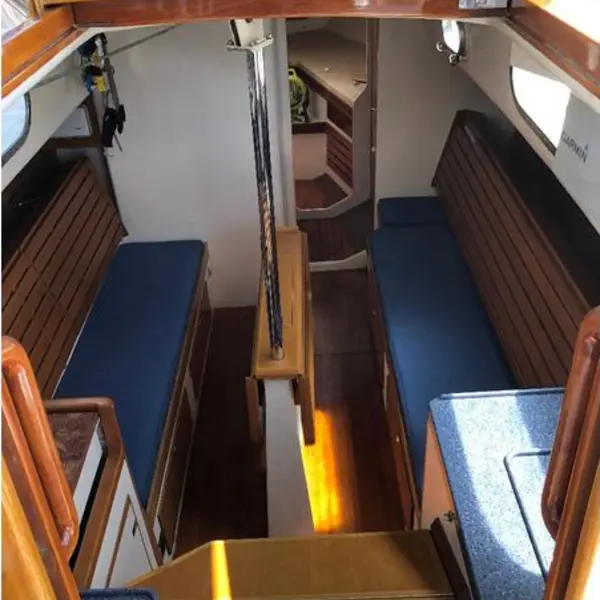
Swiftsure 33 (Rhodes) is a 33′ 0″ / 10.1 m monohull sailboat designed by Philip Rhodes and built by Amsterdam Shipyard G. de Vries Lentsch and Seafarer Yachts between 1959 and 1965.
- Designer
- Philip Rhodes
- Associations
- ?
- # Built
- 150
- Hull
- Monohull
- Keel
- Stub + Centerboard
- Rudder
- ?
- Construction
- FG
Dimensions
- Length Overall
- 33′ 0″ / 10.1 m
- Waterline Length
- 22′ 11″ / 7 m
- Beam
- 10′ 0″ / 3.1 m
- Draft
- 3′ 6″ / 1.1 m — 6′ 7″ / 2 m
- Displacement
- 11,500 lb / 5,216 kg
- Ballast
- 3,400 lb / 1,542 kg

Rig and Sails
- Type
- Sloop
- Reported Sail Area
- 502′² / 46.6 m²
- Total Sail Area
- 500′² / 46.5 m²
Mainsail
- Sail Area
- 251′² / 23.3 m²
- P
- 34′ 2″ / 10.4 m
- E
- 14′ 8″ / 4.5 m
- Air Draft
- ?
Foresail
- Sail Area
- 249′² / 23.2 m²
- I
- 38′ 8″ / 11.8 m
- J
- 12′ 10″ / 3.9 m
- Forestay Length
- 40′ 9″ / 12.4 m
Auxilary Power
- Make
- Universal
- Model
- Atomic 4
- HP
- 30
- Fuel Type
- Gas
- Fuel Capacity
- 28 gal / 106 l
Accomodations
- Water Capacity
- 60 gal / 227 l
- Holding Tank Capacity
- ?
- Headroom
- ?
- Cabins
- ?
Calculations
- Hull Speed
-
6.0 kn
Classic: 6.42 kn
Hull Speed
The theoretical maximum speed that a displacement hull can move efficiently through the water is determined by it's waterline length and displacement. It may be unable to reach this speed if the boat is underpowered or heavily loaded, though it may exceed this speed given enough power. Read more.
Formula
Classic hull speed formula:
Hull Speed = 1.34 x √LWL
A more accurate formula devised by Dave Gerr in The Propeller Handbook replaces the Speed/Length ratio constant of 1.34 with a calculation based on the Displacement/Length ratio.
Max Speed/Length ratio = 8.26 ÷ Displacement/Length ratio.311
Hull Speed = Max Speed/Length ratio x √LWL
- Sail Area/Displacement
-
15.8
<16: under powered
Sail Area / Displacement Ratio
A measure of the power of the sails relative to the weight of the boat. The higher the number, the higher the performance, but the harder the boat will be to handle. This ratio is a "non-dimensional" value that facilitates comparisons between boats of different types and sizes. Read more.
Formula
SA/D = SA ÷ (D ÷ 64)2/3
- SA: Sail area in square feet, derived by adding the mainsail area to 100% of the foretriangle area (the lateral area above the deck between the mast and the forestay).
- D: Displacement in pounds.
- Ballast/Displacement
-
29.6
<40: less stiff, less powerful
Ballast / Displacement Ratio
A measure of the stability of a boat's hull that suggests how well a monohull will stand up to its sails. The ballast displacement ratio indicates how much of the weight of a boat is placed for maximum stability against capsizing and is an indicator of stiffness and resistance to capsize.
Formula
Ballast / Displacement * 100
- Displacement/Length
-
425.6
>400: very heavy
Displacement / Length Ratio
A measure of the weight of the boat relative to it's length at the waterline. The higher a boat’s D/L ratio, the more easily it will carry a load and the more comfortable its motion will be. The lower a boat's ratio is, the less power it takes to drive the boat to its nominal hull speed or beyond. Read more.
Formula
D/L = (D ÷ 2240) ÷ (0.01 x LWL)³
- D: Displacement of the boat in pounds.
- LWL: Waterline length in feet
- Comfort Ratio
-
31.6
30-40: moderate bluewater cruising boat
Comfort Ratio
This ratio assess how quickly and abruptly a boat’s hull reacts to waves in a significant seaway, these being the elements of a boat’s motion most likely to cause seasickness. Read more.
Formula
Comfort ratio = D ÷ (.65 x (.7 LWL + .3 LOA) x Beam1.33)
- D: Displacement of the boat in pounds
- LWL: Waterline length in feet
- LOA: Length overall in feet
- Beam: Width of boat at the widest point in feet
- Capsize Screening
-
1.8
<2.0: better suited for ocean passages
Capsize Screening Formula
This formula attempts to indicate whether a given boat might be too wide and light to readily right itself after being overturned in extreme conditions. Read more.
Formula
CSV = Beam ÷ ³√(D / 64)
- Beam: Width of boat at the widest point in feet
- D: Displacement of the boat in pounds
Notes
Rhodes Design #692
The original design, and a later model marketed as the COMMODORE SWIFTSURE, were both sold through Seafarer Yachts. They share the same hull shape, exterior deck layout, and sailplan (displacement and ballast differ slightly).
The first boats, built by G. deVries Lentch, Inc., have a permanently-fixed cabin table with two leaves that fold down when not in use. At the aft end of the table is a hollow stainless pole that runs from the cabin sole to the bottom of the cabin ceiling, through which, runs a housing for the centerboard control cable.
The later model, mostly built by Royal Netherlands Aircraft, has a cabin table which completely folds away when not in use, as well as a new centerboard mechanism which operated by a control cable routed inside the port cabinetry.
The original SWIFTSURE has bronze deck hardware and fittings, and mahogany trim, while the COMMODORE version is fitted with stainless steel and aluminum hardware with teak trim.










